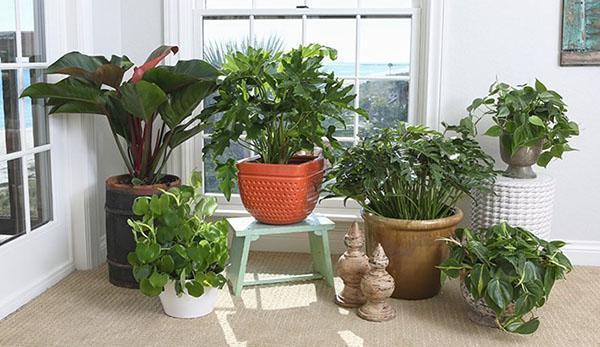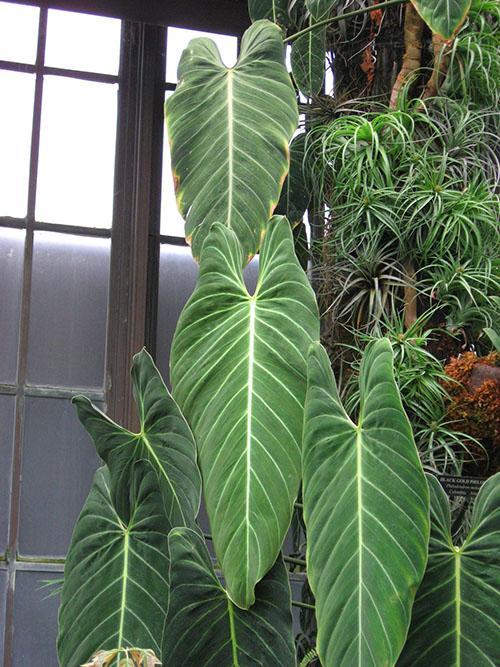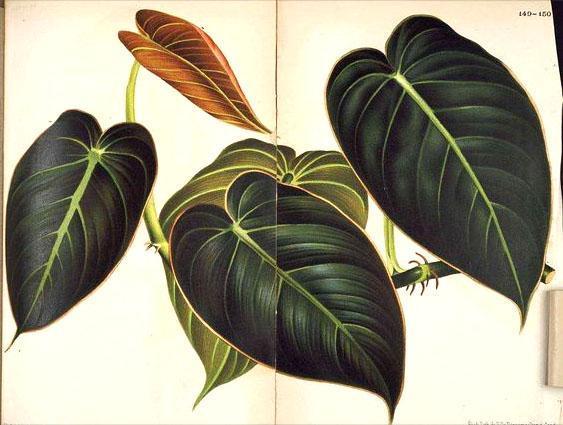Such bright unusual types of philodendron in the interior of your home
 It would seem that in the 21st century, science should know everything about the plant world. However, numerous types of philodendrons still continue to amaze scientists, become the cause of their disputes and even revise the accepted classification of plants.
It would seem that in the 21st century, science should know everything about the plant world. However, numerous types of philodendrons still continue to amaze scientists, become the cause of their disputes and even revise the accepted classification of plants.
The reason lies in the rare diversity and variability of the indigenous inhabitants of the tropical zone of South America, Oceania and Southeast Asia. Today, botanists have nearly a thousand varieties of philodendrons. They differ from each other in the size and shape of the leaves, lifestyle, colors and other qualities. It is not surprising that plant lovers are happy to "tame" the inhabitants of the humid tropics. Descriptions and photos of the most common types of philodendron when growing at home will help you more easily navigate in their colorful kingdom.
Philodendron golden black, or Philodendron Andre (P. melanochrysum)

 As early as the 19th century, botanists obtained the golden-black Black Gold philodendron variety with almost black adult leaves retaining a bronze or golden edging.
As early as the 19th century, botanists obtained the golden-black Black Gold philodendron variety with almost black adult leaves retaining a bronze or golden edging.
Philodendron giant (P. giganteum)
 The largest representative of the genus of philodendrons is considered to be the giant philodendron, native to the islands of the Caribbean and a number of regions of South America. Living under the crowns of a tropical forest, these plants reach a height of 4–5 meters, and their rounded-heart-shaped leaves can grow up to 90 cm in length.
The largest representative of the genus of philodendrons is considered to be the giant philodendron, native to the islands of the Caribbean and a number of regions of South America. Living under the crowns of a tropical forest, these plants reach a height of 4–5 meters, and their rounded-heart-shaped leaves can grow up to 90 cm in length.
It is not surprising that such a remarkable species of philodendron was discovered in the middle of the 19th century, and today it adorns the best botanical gardens and greenhouses in the world.
Philodendron warty (P. verrucosum)
 Among its fellows, the warty philodendron stands out for its versatility and unique appearance of the leaves. If other types of philodendrons rarely change their habits and are either epiphytes or terrestrial plants, then this plant easily adapts to any conditions. It can be found both under tree crowns and on them. Climbing lianas easily root in the ground and find food on the branches.
Among its fellows, the warty philodendron stands out for its versatility and unique appearance of the leaves. If other types of philodendrons rarely change their habits and are either epiphytes or terrestrial plants, then this plant easily adapts to any conditions. It can be found both under tree crowns and on them. Climbing lianas easily root in the ground and find food on the branches.
 The decoration of the plant is its heart-shaped patterned leaves. Moreover, a purple or brownish ornament formed by green veins is not on the front, but on the back. A somewhat compressed leaf blade 15–20 cm long is supported on a long petiole covered with greenish pile.
The decoration of the plant is its heart-shaped patterned leaves. Moreover, a purple or brownish ornament formed by green veins is not on the front, but on the back. A somewhat compressed leaf blade 15–20 cm long is supported on a long petiole covered with greenish pile.
Philodendron guitar (P. panduriforme)
 As they mature, the leaves of many philodendron species undergo an amazing metamorphosis. From lanceolate or cordate, they turn into pinnate, finger-like or lobate. No exception is the guitar-shaped philodendron.
As they mature, the leaves of many philodendron species undergo an amazing metamorphosis. From lanceolate or cordate, they turn into pinnate, finger-like or lobate. No exception is the guitar-shaped philodendron.
This liana, which grows up to 4 - 6 meters in nature, is almost half the size in a pot culture. But at the same time it does not lose the ability to transform.And adult plants are striking with bizarre three-lobed leaves that reminded botanists of the appearance of the ancient Greek musical instrument, after which this type of philodendron was named.
Sometimes young plants of the guitar philodendron are confused with the bipinnate philodendron, but when these large indoor species mature, the difference between them becomes obvious even to a non-specialist.
Philodendron bipinnate or Sello (P. bipinnatifidum)
 This variety has many names and can serve as a perfect illustration of the story of decades of confusion over the classification of philodendrons. Most often, flower growers know the plant under the names of the double-peristone-cut philodendron, Sello or double-peel.
This variety has many names and can serve as a perfect illustration of the story of decades of confusion over the classification of philodendrons. Most often, flower growers know the plant under the names of the double-peristone-cut philodendron, Sello or double-peel.
If the name Philodendron Sello was given in honor of the famous explorer of flora and naturalist, then the other names are a tribute to the unusual shape of intricately cut multi-lobed leaves reaching a length of 40–70 cm.
 Interestingly, the very young Sello philodendrons, like other varieties, have a solid, pointed, heart-shaped leaves. In addition, the bipinnate philodendron is a rare variety that has long been used on the farm.
Interestingly, the very young Sello philodendrons, like other varieties, have a solid, pointed, heart-shaped leaves. In addition, the bipinnate philodendron is a rare variety that has long been used on the farm.
The indigenous population uses aerial roots to make homemade ropes. Leaves and petioles give healing, as residents believe, juice.
 Botanists who have studied the Sello philodendron have noticed that the temperature around the anthers inexplicably rises by almost 13 ° C during flowering. As a result of this phenomenon, the sweetish-honey smell increases sharply, which literally attracts pollinating insects to the plant. The juicy berries of Philodendron bipinnate ripening in place of faded ears are edible.
Botanists who have studied the Sello philodendron have noticed that the temperature around the anthers inexplicably rises by almost 13 ° C during flowering. As a result of this phenomenon, the sweetish-honey smell increases sharply, which literally attracts pollinating insects to the plant. The juicy berries of Philodendron bipinnate ripening in place of faded ears are edible.
Philodendron reddish or blushing (P. erubescens)
 Another liana in the constellation of philodendron species for home cultivation is the blushing philodendron, which gave growers a lot of varieties with original, including variegated heart-shaped or pointed-ovoid leaves.
Another liana in the constellation of philodendron species for home cultivation is the blushing philodendron, which gave growers a lot of varieties with original, including variegated heart-shaped or pointed-ovoid leaves.
 The name of the plant was given by the reddish petioles, internodes, and in some cases the leaf plates of this climbing, almost non-branching liana.
The name of the plant was given by the reddish petioles, internodes, and in some cases the leaf plates of this climbing, almost non-branching liana.
 Noticing an unusual shade for other philodendrons, breeders at the moment have received a lot of interesting varieties with pinkish, picture-green, densely purple and marble leaves.
Noticing an unusual shade for other philodendrons, breeders at the moment have received a lot of interesting varieties with pinkish, picture-green, densely purple and marble leaves.
 In addition to increased decorativeness, the cultivated varieties of the blushing philodendron have more compact sizes and better adaptability to indoor conditions.
In addition to increased decorativeness, the cultivated varieties of the blushing philodendron have more compact sizes and better adaptability to indoor conditions.
Arrowhead philodendron (P. sagittifolium)
 This species of philodendron first came to the attention of scientists in 1849, and since then, thanks to the elongated solid leaves and unpretentiousness, the indigenous inhabitant of many parts of Central America has become a welcome guest of greenhouses and botanical gardens.
This species of philodendron first came to the attention of scientists in 1849, and since then, thanks to the elongated solid leaves and unpretentiousness, the indigenous inhabitant of many parts of Central America has become a welcome guest of greenhouses and botanical gardens.
For home cultivation, the arrowhead philodendron is too large, because its leaves can reach a length of 70 cm, and the petioles - 1 meter.
Scaly philodendron (P. squamiferum)
 The peculiarity of this large liana with intricately dissected 5-lobed leaves is long petioles covered with reddish pile. Obviously, thanks to this, the scaly philodendron got its name.
The peculiarity of this large liana with intricately dissected 5-lobed leaves is long petioles covered with reddish pile. Obviously, thanks to this, the scaly philodendron got its name.
 The leaves, like all philodendrons, are at first solid, three-, and then five-lobed in length can grow up to 30 cm. Aerial roots help the plant to climb steep surfaces and hold on to any suitable supports.
The leaves, like all philodendrons, are at first solid, three-, and then five-lobed in length can grow up to 30 cm. Aerial roots help the plant to climb steep surfaces and hold on to any suitable supports.
Drip Philodendron (P. guttiferum)
 This South American species of philodendron was described and studied in the first half of the nineteenth century. Like many of it, the droplet philodendron can settle both on the ground and on the branches, and in the terrestrial form, this liana is almost twice as miniature and modest as a similar epiphyte.
This South American species of philodendron was described and studied in the first half of the nineteenth century. Like many of it, the droplet philodendron can settle both on the ground and on the branches, and in the terrestrial form, this liana is almost twice as miniature and modest as a similar epiphyte.
Keeping on short stalks, oblong pointed leaves on the ground do not exceed 15 cm in length, and grow up to 20-30 cm in length with vertical growth.
Philodendron graceful (P.elegans)
 When looking at a philodendron, a graceful inexperienced florist may confuse a plant with a monster or a Sello philodendron. However, despite the general similarities, these cultures also have many differences. The 40–70 centimeter long leaves of the graceful philodendron are skillfully dissected along each vein into narrow, linear lobes.
When looking at a philodendron, a graceful inexperienced florist may confuse a plant with a monster or a Sello philodendron. However, despite the general similarities, these cultures also have many differences. The 40–70 centimeter long leaves of the graceful philodendron are skillfully dissected along each vein into narrow, linear lobes.
Ivy philodendron (P. hederaceum)
 One of the smallest, smallest and most popular philodendron species among florists can be considered the most ambiguous. The ivy philodendron at different times, and sometimes even today, is called the climbing philodendron, the brilliant, clinging or pointed philodendron. No other variety can "boast" such a wide range of names. However, the plant does not hold human love!
One of the smallest, smallest and most popular philodendron species among florists can be considered the most ambiguous. The ivy philodendron at different times, and sometimes even today, is called the climbing philodendron, the brilliant, clinging or pointed philodendron. No other variety can "boast" such a wide range of names. However, the plant does not hold human love!
 Liana with broad-heart-shaped pointed leaves sitting on long flexible petioles is a favorite indoor culture. By popularity, the plant argues with a similar one scindapsus (photo).
Liana with broad-heart-shaped pointed leaves sitting on long flexible petioles is a favorite indoor culture. By popularity, the plant argues with a similar one scindapsus (photo).
 In nature, there are specimens with smooth dark green foliage that perfectly withstands deep shadow. Today, at the disposal of lovers of indoor floriculture, there are varieties not only with marble coloring with lemon and white spots. A variety of brilliant philodendron with completely yellow leaves is bred.
In nature, there are specimens with smooth dark green foliage that perfectly withstands deep shadow. Today, at the disposal of lovers of indoor floriculture, there are varieties not only with marble coloring with lemon and white spots. A variety of brilliant philodendron with completely yellow leaves is bred.
Philodendron lobular (P. laciniatum)
 Among plants with feathery leaves, the lobular philodendron, growing as an ampelous species or climbing liana, always enjoys increased attention. A bright decoration of the plant is fancy leaves up to 40 cm long, cut into uneven lobes.
Among plants with feathery leaves, the lobular philodendron, growing as an ampelous species or climbing liana, always enjoys increased attention. A bright decoration of the plant is fancy leaves up to 40 cm long, cut into uneven lobes.